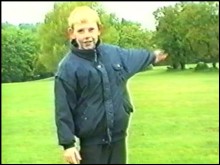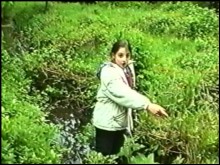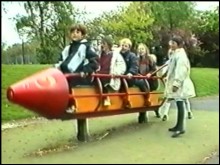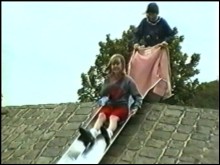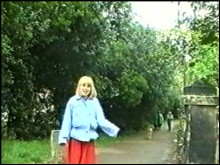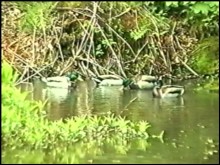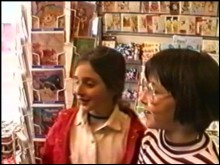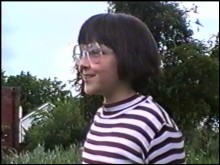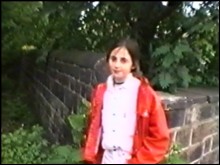Centre for Creative Media Research > Video Critical
Weetwood
Primary School:
Photographs and description of the video
|
|
The edited video (20 minutes 14 seconds): The titles are accompanied by shots of children playing outside the school, flowers in the school garden, and local scenery, which includes more natural beauty than we have seen in previous videos. Alisa and Fiona introduce us to the school, then Lindsay shows us the entrance to Meanwood Park. We cut to Hannah, standing amongst much greenery in the park: 'Hello. This is one of Meanwood's many becks. Under this bridge here, although you can't see it, there is lots of bits of plastic, and it is very overgrown. [...] It is very polluted around here, and not at all nice to swim in'. Alisa, on a bridge, says: 'This is one of the many becks in Meanwood. It has got a lot of pollution in it, and if there were fishes in it, they would be dead'. Then we go to Thomas, on another bridge: 'This is the main beck of Meanwood Park. As you can see, they drop quite a lot of sewage in here, because they don't have enough facilities to dump them in anywhere else, so they come and just pump it into the beck'. Andrew shows us the grassy expanses of the park. 'People come here for picnics, and there's football pitches over there, and there's a kids' playground just round there'. Music starts up, and we see the group demonstrating the play facilities. Then, as we watch policemen cross the park on horseback, we hear Hannah talking about the contrast between the largely clean and tidy park, and the pollution in its becks. She also mentions the traffic pollution on Otley Road. Lindsay and Alisa admire the bluebells and other flowers in the park. Fiona shows us the ducks in the duck pond. 'Earlier on in spring, you can see lots of frogspawn in the pond, and, um, some people take the frogspawn from the pond, and put it in their ponds at home'. Lindsay tells us that she has tadpoles from this pond. The children are seen walking off into the woods, whilst Alisa sits down wearily on a rock: 'I'm enjoying the nature. Ahh!'. Lindsay, seated on another rock, tells us about Meanwood Park's woods: 'In the woods, you can see lots of squirrels, and birds. If you're lucky you might be able to see a rabbit. I haven't seen one yet. In winter and autumn, people put out bins and people collect acorns in them, and then they sell them, and raise money. You can also see that there are lots of stones, and hills to climb, like this one'. Hannah reads us a warning notice, strapped to a tree: 'Danger - pollution. Water contact should be avoided. Untreated human sewage may be present...'. Then, to music, we see the group walking through gardens, and examining a war memorial, until we arrive at a church, to the sound of its chiming bells. Fiona and Hannah tell us about it. The group are then seen examining the sunny graveyard, and then cutting through woods towards Beckett Park, which Andrew introduces us to. As we watch a man, in the distance, throwing his boomerang in the park, we hear Thomas ask Hannah, 'Why have you done this video?'. She replies: 'To show other people what they can do, and what is actually happening to their environment'. Music starts as we see the boomerang man at closer quarters. Then Thomas interviews him about boomerangs, and the park. The man is impressed by the park: 'I'm amazed how quiet it is. [...] Yeah, it's good here. Not many people to hit'. Then we see all of the children, gathered around, asking him about the activity, and techniques. Next, to music, the children try out various boomerangs in the park. We cut to a busy road, with traffic pouring along. Hannah: 'This is Otley Road. It is one of the busiest roads near our school. In the mornings and the evenings, during the rush hour, there are usually lots and lots of traffic jams'. Then we see more noisy traffic, with the sound fading so that we can hear a poem about pollution, by a classmate of the group, which concludes 'Dead fish float in the dirty water / So much waste adds to the slaughter / Acid rain destroys the trees / Dirty leaves blown by a strong breeze / Men's hunger for paper kills the wood / Will they stop? They really should'. Then we cut to the interior of the local Post Office, where Alisa and Hannah interview the shopkeeper. He thinks the pollution from the road must be quite bad, but the litter problem is less severe, except after Friday and Saturday nights. He likes the area very much. In a nearby delicatessen, the shopkeeper - interviewed by Hannah and Alisa - echoes these views. 'The air's horrible [...] There's a lot of traffic pollution [...] Once you get away from that road, it's very nice indeed'. Continuing along the Otley Road, Hannah notes more dumped rubbish. Interviewing the proprietor of a restaurant, Alisa and Lindsay find more accounts of traffic pollution, but are pleased to note that the restaurant recycles its wine bottles. In the school garden, Lindsay asks Alisa, 'Did you enjoy making the video?'. She replies, 'Yes, we had a lot of fun'. Then Alisa interviews Fiona: 'Did you enjoy it?'. 'Yes, I did'. 'What did you learn about the environment?'. 'Well, I learnt that the environment round us can be nice, but the problem is sometimes you find there's pollution as well'. Then we enter the closing title sequence, featuring shots of the children, including Hannah explaining acid rain before a large frieze in class; and a squirrel in Beckett Park. |
![]()
The text and images on this site are by David Gauntlett, © 1997, 2004.
Back to > Video Critical home.


